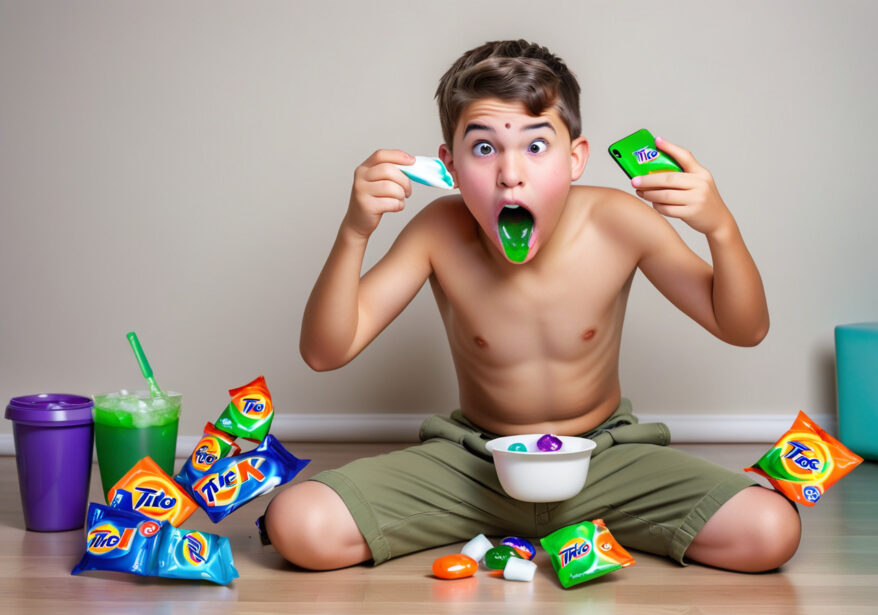You check Instagram. You remember how it once felt like a beautiful digital gallery — filtered sunsets, vacations, workouts, art. Now, it refreshes like a pinball machine on MDMA: a chaotic bombardment of incel propaganda, therapy-speak buzzwords, bestiality memes, fake crying, pro-ana cheerleading, scam ads, and lo-fi Nazi ideology wedged between dancing influencers. You delete it.
You feel the pull to reinstall within minutes.
Phase One: Collapse of Context
The screen was once your compass. Now it’s a kaleidoscope of distortion.
Your child asked you yesterday whether we really went to the moon. A few days earlier, he told you one of his classmates thinks the Earth is flat. Another student, he says, believes vaccines turn you gay.
You want to laugh. You want to explain. But you’re also exhausted.
The headlines spin across your feeds like satire:
- “Students Demand Safe Spaces for Eating Tide Pods on Campus”
- “71% of Med Students Misidentify Basic Female Anatomy”
- “Influencer Cooks Her Dog, Claims It’s a Meta-Art Piece”
At first, you blamed algorithms. Then you blamed schools. Now, you wonder if this is simply the consequence of too many people staring at glowing rectangles all day while reading nothing longer than a tweet.
Everything is a hot take. Everyone is angry. No one seems able to explain why.
And the context is gone.
Phase Two: Digital Dependency

Your dumbest friend rage-texts you because you didn’t respond within five minutes. You try explaining that you were cooking, or walking, or reading.
It doesn’t matter. The response isn’t about information, it’s about possession. You are expected to be accessible, on demand, like a vending machine for comfort and content.
You decide to detox.
Just three days. No phone. No computer. No connected devices. The first day feels like withdrawal. The second is eerie. The third is peace.
You sleep better. You think clearer.
But when you return to your devices, the consequences have already arrived.
Dozens of angry messages from that same friend:
- “You ghosted me? Really?”
- “Unbelievable.”
- “How can you betray a friend like this?”
You realize that friendship, too, has been corrupted by instant gratification.
Phase Three: Culture of Death
You remember raising your son. His love of building things. His endless questions about animals and the stars.
Now, he flinches when spoken to. He stares at his phone for twelve hours straight. He scrolls until his hands twitch.
You try to intervene.
“We’re going offline for a weekend,” you say. “Just us.”
He explodes.
“That’s abuse! I need to talk to my friends! You don’t understand! You’re toxic!”
Later, you find him shaking. Like withdrawal. Not from drugs. From screens.
You hide the router. He screams. Breaks a window. The school sends you a notice: your parental behavior has been reported.
The counselor tells you gently, “You should be more supportive of his needs.”
You want to scream back that the device is the problem. That he’s being rewired.
But they’ve already decided you’re the villain.
You find the videos your son was watching.
People stuffing themselves with detergent pods. Teen girls shaming each other for eating anything at all.
A livestream where a boy pours gasoline on himself for “likes.”
You lock the devices.
You spend real time with him. You teach him to cook. You rebuild a birdhouse together. You see a flicker of the boy you remember.
And then one night, he sneaks a tablet out of your drawer. It wasn’t connected to anything. But it was just enough.

The next morning, he is in the bathroom.
Too late.
The bottle is empty. The colorful plastic pod wrappers are soaked in vomit.
You hold him. His breath is shallow.
You say his name over and over again.
At the hospital, the autopsy says liquefactive necrosis of the brain and intestinal erosion.
But you already knew the truth.
It wasn’t the detergent.
It was the rot.
It was always the rot.
Epilogue: Five Years Later
You sit in a quiet community center. The lights are low. The coffee is terrible. But you are here.
It’s been five years since your son’s death. Five years since you swore off all the apps. Five years of silence. Of grief. Of rebuilding.
Around the circle are others like you.
A man who lost two children to the Tide Pod trend. He doesn’t speak much, but his hands shake when he holds the styrofoam cup.
A woman whose daughter starved herself into a coma after falling into a pro-ana TikTok rabbit hole. She brings a faded picture of her daughter every week. Just to hold it.

And a man who lost his best friend to something darker. His friend followed a link from an “apemantic” TikTok account — a monkey brothel ad. One encounter. One exposure. He died in agony from total organ failure caused by Candara Pangi Hemorrhagic Fever. The doctors couldn’t even track the viral origin fast enough to stop the bleeding.
No one blames the apps anymore. They blame themselves. They blame each other. Then they remember: none of them built the machine.
And slowly, they start to talk.
There are tears.
But there is laughter too.
Someone makes a joke about the feed being gone. Another adds, “I haven’t doomscrolled in five years. I call that a miracle.”
They don’t call it healing. They call it remembering who they were before the rot.
And you, for once, feel less alone.
Next Week: Episode 30 — “What would happen if the Milky Way’s black hole erupted?“

